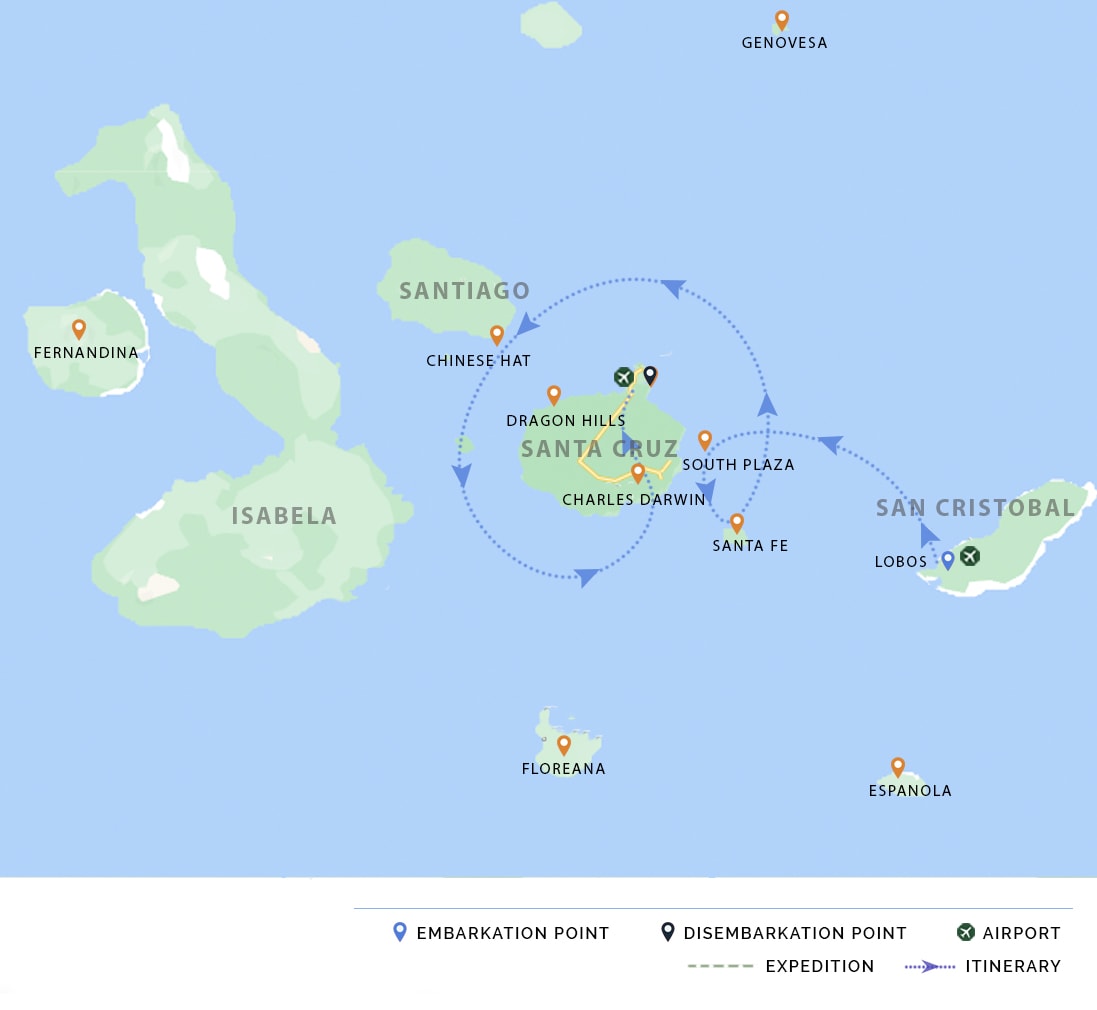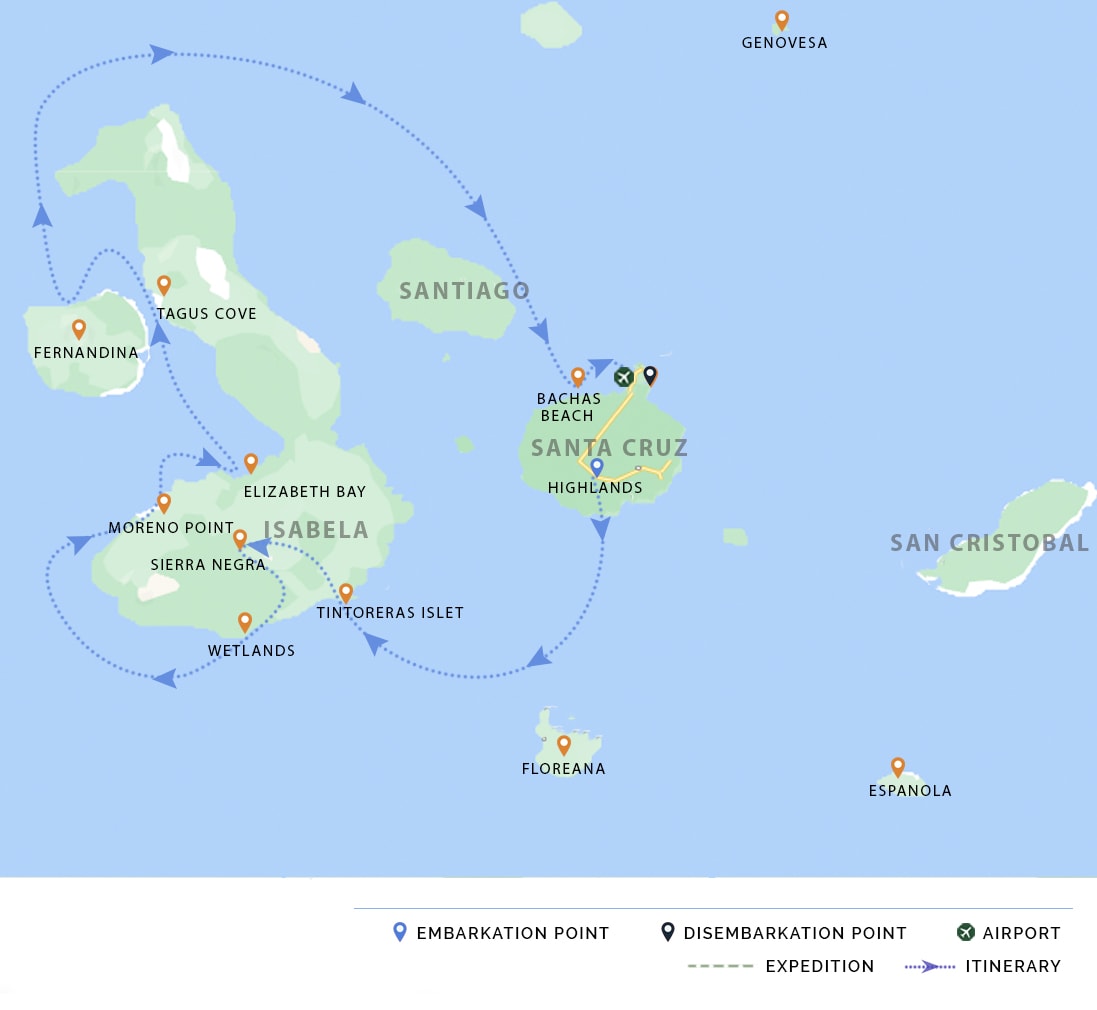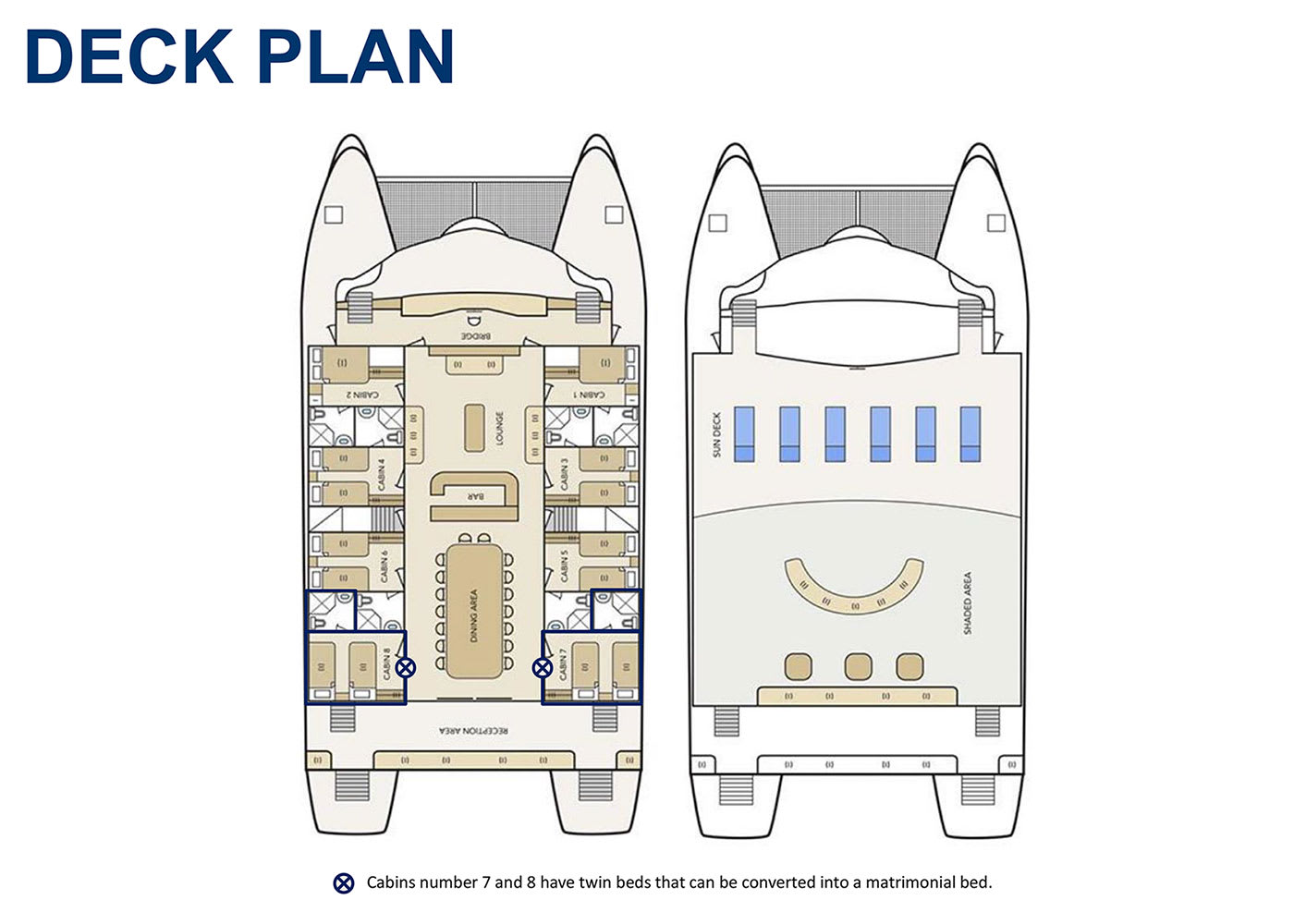Overview
The first-class motor catamaran Analí (formerly the Archipel II) is a 16-passenger ship with eight twin, matrimonial, or convertible cabins. The yacht offers a unique eight passengers-to-guide ratio, ensuring guests get the most out of each visitor site and activity.
The catamaran’s design ensures maximum stability, providing a safe and comfortable cruising experience. All cabins have large windows that offer stunning views of the islands and air conditioning to ensure guests’ comfort. The cabins also feature private bathrooms and ample storage space for luggage.
Life On Board
Analí passengers experience the highest level of service and comfort. The crew ensures that all cabins are attended to daily, providing fresh towels, drying service, and anything else guests need to enjoy their cruise.
Additionally, the catamaran boasts spacious common areas where passengers can relax and unwind after a day of exploration. Whether you prefer to lounge on the sundeck, sunbathe in the hammocks in the front of the yacht while enjoying the cool breeze, have cocktails in the bar, or marvel at the breathtaking scenery, there is no shortage of ways to unwind on the Analí.
Unlike most other Galapagos cruises, the M/C Analí offers onboard Wi-Fi connectivity ensuring that you can conveniently stay in touch with your loved ones and share your incredible experiences as they unfold, allowing you to stay connected while immersing yourself in the wonders of the islands.
Entertainment
For entertainment the catamaran features a conference area with a smart TV, projector, library, and board games, while off-ship Analí also has a kayak and paddleboard, as well as ample snorkel gear (mask, snorkel, and fins).
Analí is the perfect choice for a comfortable and and great value Galapagos cruise experience. With its exceptional service, it promises to be a once-in-a-life time adventure that you will never forget.
Itineraries & Prices
All itineraries are subject to change due to seasonal weather conditions (and resultant variations in river and tributary water levels) affecting accessibility to locations. Thus navigation routes, times and excursions may need to be modified at the cruise captain’s or your guide's discretion.
Embarkation
PM: After arriving at San Cristobal airport, we will be greeted by our naturalist guide to then board the M/C Analí for lunch. Following our meal, we will navigate a short distance to Lobos Island. This visitor site has an 850-meter trail that crosses the island. There is a small population of blue-footed boobies and common frigate birds nesting at this site, that is also inhabited by the two species of sea lions present in the archipelago. This is also a great site for snorkeling, as the waters are calm and not so deep.

South Plaza Island & Santa Fe Island
AM: After a dry landing on one of the oldest docks of the archipelago on colorful South Plazas, we will explore the home to vibrant green prickly pears, deep red Sesuvium, and coppery‐orange land iguanas. Impressive seaward cliffs make the perfect perching spot for a variety of coastal birds. This is also a great place to observe the adult and pup sea lions swimming along the shores.
PM: After a wet landing on Santa Fe, we will explore a white sand beach where sea lions are usually resting. We will be looking for the endemic species of land iguana, larger and more yellow than land iguanas on other islands. The largest prickly pear cacti in the Galapagos are also found here.

Chinese Hat & Dragon Hill
AM: Less than a quarter of one square kilometer in size, this island gets its name from being shaped like a Chinese hat. The shape is best appreciated from the north side. Lava formations can be seen on the island's western side, formed under the sea and later raised upward, making it possible to observe coral heads on the lava.
PM: We head across to Cerro Dragon on Santa Cruz’s northwest shore (dry landing) to visit a saltwater lagoon, home to Greater Flamingos, black‐necked stilts, and white‐cheeked pintails. Further inland we can observe a fantastic land iguana nesting site.

Disembarkation
AM: We will visit Charles Darwin Research Station to observe giant tortoises from different islands. They are found in large semi natural pens for their protection and to ensure easy viewing for visitors.
After this visit, we will continue our way to the Baltra airport for the departing flight to mainland Ecuador.

Embarkation
PM: Upon arrival to the Baltra airport, we will be greeted by our naturalist guide to then board the M/C Analí and have lunch. Afterward, we will navigate a short distance to North Seymour, a small uplifted island, where we will observe up close colonies of nesting great frigatebirds, blue-footed boobies, and swallow-tailed gulls, and experience, depending on the season, spectacular displays of mating rituals.

Pinnacle Rock, Buccaneer's Cove & Espumilla Beach
AM: After a dry landing at Bartolome, we can climb the wooden steps to the summit for a breathtaking panoramic view of the island’s iconic Pinnacle Rock and neighboring Santiago Island along with several other central islands in the distance. Afterwards, we will visit the white sand beach used as a nesting site by sea turtles. Bartolome is also a great place to spot the Galapagos penguin.
PM: At Buccaneer Cove, we will take a panga ride along the beautiful coastline. This place got its name because it used to be a refuge for British pirates who anchored here to collect supplies and clean their ships, among other activities. The cove is very scenic and offers views of the cliffs and dark beach.
We then head to Santiago Island to disembark at Espumilla (wet landing), onto a golden-colored sand beach, used by green sea turtles as a nesting site. A forest trail will take us through some of the largest specimens of Palo Santo on the islands to observe yellow warblers, the amazing Galapagos flycatcher, and Darwin finches.

Puerto Egas & Rabida
AM: At Puerto Egas (wet landing), we disembark onto a dark sand volcanic beach with an interesting history of human settlers. Sleepy Galapagos fur seals lounge under arches of lava carved by the ocean and occasionally dip into the crystalline pools, also known as ‘grottos.’ A walk along the shore offers the opportunity to observe the abundant marine life.
Be amazed by the landscapes covered by sea lions’ colonies, marine iguanas, and Galapagos penguins.
PM: After a wet landing onto Rabida’s deep-red beach, we can explore the red island’s fascinating interior and saltwater lagoon where flamingos are usually present. Darwin’s finches, Galapagos mockingbirds, and yellow warblers feed off the vegetation. Given the right time of the year, we may see brown pelicans nesting on salt bushes near the beach.

Disembarkation
PM: We will spend this morning visiting one of Santa Cruz Island’s most famous attractions. After a dry landing at the Puerto Ayora passenger pier, we head to the Charles Darwin Research Station. Here, we will see tortoises from several different islands. The animals are found in large semi-natural pens for their protection and to ensure an easy view for visitors. The pens are divided according to four different stages of development: eggs, neonates, juveniles (held here until they are mature enough to be repatriated), and adults.
After the visit, we will transfer to the Baltra airport for the flight back to the mainland.

Embarkation
PM: After arriving at Baltra airport, we will be greeted by our personnel to then cross the Itabaca channel and reach Santa Cruz Island for our first visit in the Archipelago The Highlands of Santa Cruz.
We will visit one of the ranches of the area where it is possible to see giant tortoises in their natural habitat As these animals migrate from the coastal area to the highlands and back, the chosen ranch will depend on the presence of the tortoises since they roam free and change locations Then, we will head to the M/C Analí.

Tintoreras, Sierra Negra Volcano, Wetlands & Arnaldo Tupiza Breeding Center
AM: This area concentrates a lot of marine life that is easy to spot from the dingy or kayak These tranquil waters are home to sea turtles, sea lions, rays, blue-footed boobies and other marine species This site is also famous for the channels formed by the lava and that are used as resting sites by the white-tipped reef sharks, known locally as “Tintoreras After visiting Tintoreras, we will climb Sierra Negra Volcano Its caldera is considered to be the second largest in the world, measuring nine kilometers from east to west and 10 kilometers from north to south After leaving the transport, visitors hike up a trail to reach the rim of the crater for spectacular views of the crater and the nearby Volcan Chico, as well as the extensive lava fields created by the shield volcanos that have created this island.
PM: The Arnaldo Tupiza Tortoise breeding center helps to repopulate the island with young adults of the five species, threatened in their natural habitat by introduced animals such as goats, cats, and rats. By the end of the day we will visit Isabela ´s Wetlands, which are a group of swamps and lagoons surrounded by mangrove trees This site is considered one of the best near Puerto Villamil for spotting migratory birds, as a the path takes visitors through the wetlands, where is easy to see flamingoes, whimbrels, common stilts, and gallinules

Punta Moreno & Elizabeth Bay
AM: We arrive at Isabela, the largest island in the Galapagos After breakfast, we step ashore at Punta Moreno (dry landing) onto a superb pahoehoe lava flow surrounded by giant shield volcanoes, some of which are still active! From here we will do a short hike to a lagoon where flamingos are usually present.
PM: In the afternoon, you take a panga ride around the islets of Elizabeth Bay, Isabela Island, to see marine iguanas, penguins, marine turtles, seabirds, shorebirds, herons and blue-footed boobies.

Tagus Cove & Espinoza Point
AM: Dry landing near Tagus Cove, a historical pirate hideaway where names of countless ships are recorded for posterity on the cliff face Hike through beautiful Galapagos landscapes to Darwin Lake, a saltwater crater lagoon surrounded by tuff stone.
PM: We cross the Bolivar Channel to Fernandina Island, one of the world’s most pristine sites, and disembark (dry landing) at Punta Espinosa Strolling along the shoreline, we will be on the lookout for flightless cormorants, Galapagos sea lions, Galapagos penguins and hawks, sooty colored marine iguanas and bright red orange Sally Lightfoot crabs.

Disembarkation
AM: This visitor site has a delightful, long beach perfect for swimming or for taking a stroll to observe the wildlife The the beach is a nesting area for green sea turtles, which leave tracks in the sand after burying their eggs, especially from November to February.

Embarkation
PM: Upon arrival to the Baltra airport, we will be greeted by our naturalist guide to then visit the highlands of Santa Cruz Island. In contrast to the coastal region, the area has lush vegetation and occasionally a cloud forest-like climate due to the humidity. We will visit El Chato Ranch where it is possible to see giant tortoises in their natural habitat. As these animals migrate from the coastal area to the highlands and back throughout the year. This is also a good place to observe the ground finch and vermilion flycatcher.

Champion Islet, Cormorant Point, Baroness Lookout & Post Office Bay
AM: We spend the day on Floreana legendary homestead of infamous Baroness Eloise Von Wagner de Bousquet After snorkeling near Champion Islet we will be landing onto the olivine beaches of Punta Cormorant, where we will be seeking Greater Flamingos on the brackish lagoon on our way to another special beach with the finest sand you’ll set foot on, a sea turtle nesting ground where sharks and rays also visit regularly.
PM: After lunch, we will hike up to Baroness Lookout to see an incredible panorama views A a great place to observe the Palo Santo and Mangrove forests, as well as the coastline from the Enderby Island to Post Office Bay Cerro Straw and Punta Cormorant.
After this visit, we will disembark at Post Office Bay (wet landing), where you can leave postcards in the barrel just as the whalers did centuries ago and select cards to hand deliver when you return home.

Gardner Bay & Suarez Point
AM: We will spend the morning in the fantastic Gardner Bay (wet landing) of Española Island; an outstanding beach with sea lions, marine iguanas, and the intrepid Española mockingbird. Close to Española, there is a good spot for snorkeling called Gardner Islet. While snorkeling, there is a god chance play ful sea lions will join you. Get ready for more snorkeling at Osborn Islet, a great place to observegre at quantities of marine life.
PM: In the afternoon we will head to Suarez Point, one of the most popular landing sites in Galapagos The highlights include sea lions near the landing place, sometimes to be seen body‐surfing in the large breakers, large marine iguanas, with red‐colored males in the breeding season, oystercatchers, blue footed and Nazca boobies, Galapagos hawks, Galapagos doves, swallow‐tailed gulls, red billed tropicbirds, and three species endemic to Española the waved albatross(present only from April to December), the Española mockingbird, and the Española lava lizard The trail ends in “El Soplador a blowhole that sprays water some 25 m 75 feet) into the air.

Pitt Point, Witch Hill & Kicker Rock
AM: Punta Pitt (Pitt Point) is located in the northeastern tip of San Cristobal Island and is the only place in the archipelago where is possible to see the 3 different species of boobies (blue-footed, red footed and masked) as well as the 2 species of frigate birds sharing a common space The site has a trail that goes up a cliff and through a ravine, leading to an area with abundant birdlife This site is also known for being a good snorkeling spot of San Cristobal Island.
PM: In the afternoon, we will visit Witch Hill This place is an eroded tuff cone surrounded by a beautiful white powdery sand beach with an abundance of animals Wildlife includes sea turtles, rays, pelicans, sea lions and various types of boobies The clear water provides an excellent opportunity for swimming and snorkeling This was also one of the first places visited by Charles Darwin during his trip in the M/S Beagle.
After visiting Witch Hill, we will head to Kicker Rock, also known as “León Dormido ””(sleeping lion in Spanish This natural monument has become a favorite site for cruises due to the many tropic birds, frigates, and boobies that perch on the rocks Beneath the sea, the near crystal waters offer a brilliant show of colorful tropical fish and invertebrates Due to the sheer vertical pitch of the rock face, landings are not possible.

Disembarkation
AM: This useful point of information located in Puerto Baquerizo Moreno was opened in 1998 with the purpose of informing visitors about the origin sand geography of the Galapagos islands. The center has different sections depicting the natural and human history of the Galapagos as well as the efforts of conservation of the present.
After this visit, we will transfer to the San Cristóbal airport for the flight back to the mainland.

Embarkation
PM: After arriving at San Cristobal airport, we will be greeted by our naturalist guide to then board the M/C Analí for lunch. Following our meal, we will navigate a short distance to Lobos Island. This visitor site has an 850- meter trail that crosses the island. There is a small population of blue-footed boobies and common frigate birds nesting at this site, that is also inhabited by the two species of sea lions present in the archipelago. This is also a great site for snorkeling, as the waters are calm and not so deep.

South Plaza Island & Santa Fe Island
AM: After a dry landing on one of the oldest docks of the archipelago on colorful South Plazas, we will explore the home to vibrant green prickly pears, deep red Sesuvium, and coppery‐orange land iguanas. Impressive seaward cliffs make the perfect perching spot for a variety of coastal birds. This is also a great place to observe the adult and pup sea lions swimming along the shores.
PM: After a wet landing on Santa Fe, we will explore a white sand beach where sea lions are usually resting. We will be looking for the endemic species of land iguana, larger and more yellow than land iguanas on other islands. The largest prickly pear cacti in the Galapagos are also found here.

Chinese Hat & Dragon Hill
AM: Less than a quarter of one square kilometer in size, this island gets its name from being shaped like a Chinese hat. The shape is best appreciated from the north side. Lava formations can be seen on the western side of the island, formed under the sea and later raised upward, making it possible to observe coral heads on the lava.
PM: We head across to Cerro Dragon on Santa Cruz’s northwest shore (dry landing) to visit a saltwater lagoon, home to Greater Flamingos, black‐necked stilts, and white‐cheeked pintails. Further inland we can observe a fantastic land iguana nesting site.

Charles Darwin Research Station & Highlands of Santa Cruz
AM: We will visit Charles Darwin Research Station to observe giant tortoises from different islands. They are found in large semi natural pens for their protection and to ensure easy viewing for the visitors.
PM: The highlands, in contrast to the coastal region, have lush vegetation and often a cloud forest-like climate due to the humidity.
We will visit one of the ranches of the area where it is possible to see giant tortoises in their natural habitat. As these animals migrate from the coastal area to the highlands and back, the chosen ranch will depend on the presence of the tortoises since they roam free and change locations throughout the year. We will then transfer to the Analí.

Tintoreras, Sierra Negra Volcano, Wetlands & Arnaldo Tupiza Breeding Center
AM: This area offers an abundance of marine life that is easy to view from a dingy or kayak. These tranquil waters are home to sea turtles, sea lions, rays, blue-footed boobies, and other marine species. This site is also famous for the channels formed by lava that are used as resting sites by the white-tipped reef sharks, known locally as Tintoreras.
Afterwards, we will transfer to the entrance to the Sierra Negra Volcano. Its caldera is considered the second largest in the world, measuring nine kilometers from east to west and 10 kilometers from north to south. After leaving the vehicle, visitors hike up a trail to reach the rim for spectacular views of the crater and Chico Volcano as well as the extensive lava fields created by the shield volcanos that form this island.
PM: After lunch, we will visit the Arnaldo Tupiza giant tortoise breeding center. It helps to repopulate the island with young adults of the five species threatened in their natural habitat by introduced animals such as goats, cats, and rats. It can be reached by an elevated wooden walkway that passes through Isabela´s wetlands that are surrounded by giant mangroves. This site is considered one of the best for spotting migratory birds, where is easy to observe flamingos, whimbrels, common stilts, and gallinules.

Moreno Point & Eilzabeth Bay
AM: Isabela is the largest island in the Galapagos. After breakfast, we step ashore at Punta Moreno (dry landing) onto a superb pahoehoe lava field surrounded by giant shield volcanoes, some of which are still active. From here we will do a short hike to a lagoon where flamingos are usually present.
PM: In the afternoon, a panga ride takes us around the islets of Elizabeth Bay to observe marine iguanas, penguins, sea turtles, seabirds, shorebirds, herons, and blue-footed boobies.

Tagus Cove & Espinoza Point
AM: After a dry landing near Tagus Cove, we will visit this historic pirate hideaway where names of countless ships are recorded for posterity on the cliff face. A hike through beautiful Galapagos landscapes to Darwin Lake will provide great views of a salt-water crater lagoon surrounded by tuff stone.
PM: We cross Bolivar Channel to Fernandina Island, one of the world’s most pristine sites, and disembark (dry landing) at Punta Espinosa. Strolling along the shoreline, we will be on the lookout for flightless cormorants, Galapagos sea lions, Galapagos penguins and hawks, sooty-colored marine iguanas, and bright red-orange Sally Lightfoot crabs.

Disembarkation
AM: This visitor site has a delightful, long beach perfect for swimming or taking a stroll to observe the wildlife. The beach is a nesting area for green sea turtles that leave tracks in the sand after burying their eggs. There is more activity here from November to February.
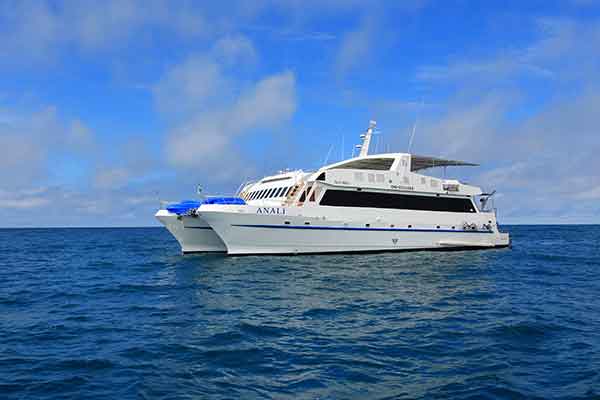
Embarkation
PM: Upon arrival to the Baltra airport, we will be greeted by our naturalist guide to then board the M/C Analí and have lunch. Afterwards, we will navigate a short distance to North Seymour, a small uplifted island, where we will observe up close colonies of nesting great frigatebirds, blue-footed boobies, swallow-tailed gulls, and experience, depending on the season, spectacular displays of mating rituals.

Pinnacle Rock, Buccaneer's Cove & Espumilla Beach
AM: After a dry landing at Bartolome, we can climb the wooden steps to the summit for a breathtaking panoramic view of the island’s iconic Pinnacle Rock and neighboring Santiago Island along with several other central islands in the distance. Afterwards, we will visit the white sand beach used as a nesting site by sea turtles. Bartolome is also a great place to spot the Galapagos penguin.
PM: At Buccaneer Cove, we will take a panga ride along the beautiful coastline. This place got its name because it used to be a refuge for British pirates who anchored here to collect supplies and clean their ships, among other activities. The cove is very scenic and offers views of cliffs and dark beaches.
We then head to Santiago Island to disembark at Espumilla (wet landing), onto a golden-colored sand beach, used by green sea turtles as a nesting site. A forest trail will take us through some of the largest specimens of Palo Santo on the islands to observe yellow warblers, the amazing Galapagos flycatcher, and Darwin finches.

Puerto Egas & Rabida
AM: At Puerto Egas (wet landing), we disembark onto a dark sand volcanic beach with an interesting history of human settlers. Sleepy Galapagos fur seals lounge under arches of lava carved by the ocean and occasionally dip into the crystalline pools, also known as ‘grottos.’ A walk along the shore offers the opportunity to observe the abundant marine life.
PM: After a wet landing onto Rabida’s deep-red beach, we can explore the red island’s fascinating interior and saltwater lagoon where flamingos are usually present. Darwin’s finches, Galapagos mockingbirds, and yellow warblers feed off the vegetation. Given the right time of the year, we may see brown pelicans nesting on salt bushes near the beach.

Charles Darwin Research Station & Highlands of Santa Cruz
AM: We will spend this morning visiting one of Santa Cruz Island’s most famous attractions. After a dry landing at the Puerto Ayora passenger pier, we head to the Charles Darwin Research Station. Here, we will see tortoises from several different islands. The animals are found in large semi-natural pens for their protection and to ensure an easy view for visitors. The pens are divided according to four different stages of development: eggs, neonates, juveniles (held here until they are mature enough to be repatriated), and adults.
PM: In the afternoon, we will visit the highlands of Santa Cruz Island. In contrast to the coastal region, the area has lush vegetation and occasionally a cloud forest-like climate due to the humidity. We will visit El Chato Ranch where it is possible to see giant tortoises in their natural habitat. As these animals migrate from the coastal area to the highlands and back throughout the year. This is also a good place to observe the ground finch and vermilion flycatcher.

Champion Islet, Cormorant Point, Baroness Lookout & Post Office Bay
AM: We will spend the day on Floreana, legendary homestead of infamous Baroness Eloise Von Wagner de Bousquet. After snorkeling near Champion Islet, we will disembark onto the olivine beach of Punta Cormorant where we hope to observe the greater flamingos in the brackish lagoon on our way to another special beach with the finest sand in the islands - a sea turtle nesting ground where sharks and rays also visit regularly.
PM: After lunch, we will hike up to Baroness Lookout for an incredible panoramic view. This is a great place to see Palo Santo trees, mangroves, and the coastline from the Enderby Island to Post Office Bay, Cerro Straw, and Punta Cormorant.

Gardner Bay & Suarez Point
AM: We will spend the morning in beautiful Gardner Bay (wet landing) on Española Island, a white sand beach populated by sea lions, marine iguanas, and the intrepid Española mockingbird. Close to Española, there is a popular spot for snorkeling called Gardner Islet. While snorkeling, there is a good chance playful sea lions will join you. Get ready for more snorkeling at Osborn Islet, a great place to observe marine life.
PM: In the afternoon we will head to Suarez Point, one of the most popular landing sites in Galapagos. The highlights include sea lions near the landing site, sometimes seen body‐surfing in the large breakers, large marine iguanas including red‐colored males during the breeding season, oystercatchers, blue-footed and Nazca boobies, Galapagos hawks, Galapagos doves, swallow‐tailed gulls, red-billed tropicbirds, and three species endemic to Española: the waved albatross (present only from April to December), the Española mockingbird, and the Española lava lizard. The trail ends in El Soplador, a blowhole that sprays water some 25 m (75 feet) into the air.

Pitt Point, Witch Hill & Kicker Rock
AM: Pitt Point is located on the northeastern tip of San Cristóbal Island and is the only place in the archipelago where is possible to see the three different species of boobies (blue-footed, red-footed and masked) as well as the two species of frigatebirds all in the same area. The site has a trail that leads up a cliff and through a ravine, to an area abundant with bird life. This site is also known for being one of the best snorkeling spots of San Cristóbal Island.
PM: In the afternoon, we will visit Witch Hill. This place is an eroded tuff cone surrounded by a beautiful white powdery sand beach with an abundance of wildlife including sea turtles, rays, pelicans, sea lions and various types of boobies. The clear water provides an excellent opportunity for swimming and snorkeling. This was also one of the first places visited by Charles Darwin during his trip on the M/S Beagle.
Afterwards, we will head to Kicker Rock, also known as León Dormido (‘sleeping lion’ in Spanish). This natural monument has become a favorite site for cruises due to the many tropicbirds, frigates, and boobies that perch on the rocks. Within the nearly crystal-clear waters enjoy the impressive variety of colorful tropical fish and invertebrates. Due to the sheer vertical pitch of the rock face, landings here are not possible.

Disembarkation
AM: The interpretation center, located in the town of Puerto Baquerizo Moreno, capital of the Galapagos province, was opened in 1998 with the purpose of informing visitors about the origins and geography of the islands. The center has different areas offer the opportunity to appreciate the natural and human history of the Galapagos Islands as well as the current conservation efforts to preserve them.
After this visit, we will transfer to the San Cristóbal airport for the flight back to the mainland.

Accommodations
Social Areas
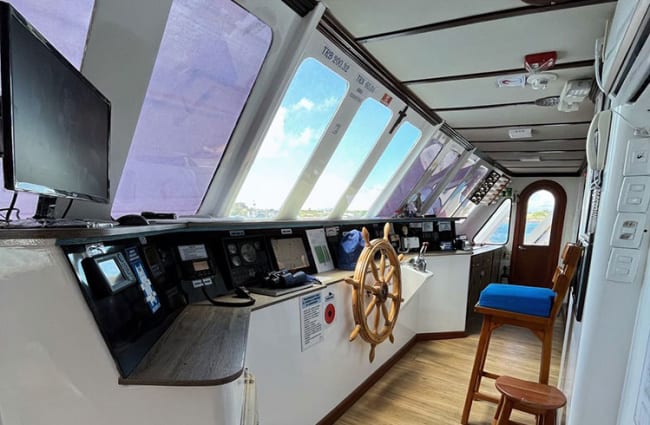
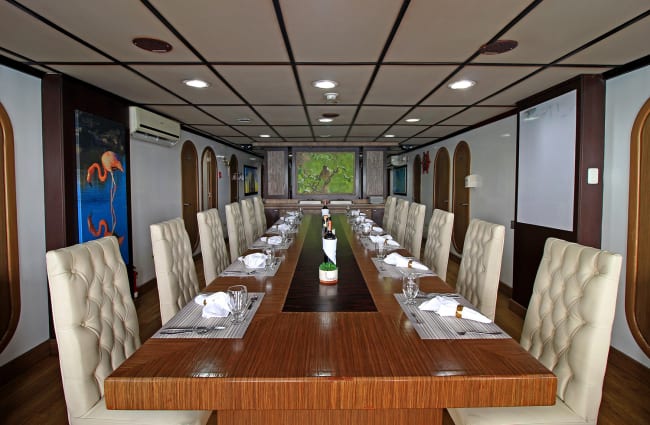
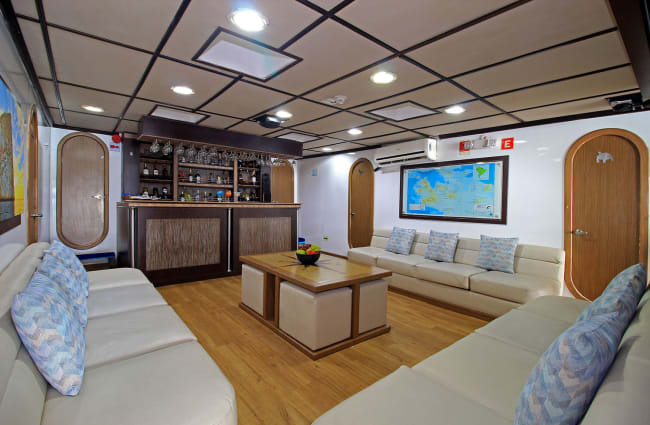
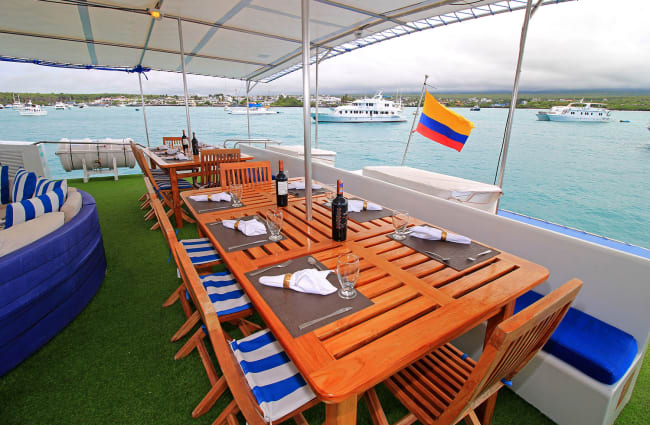
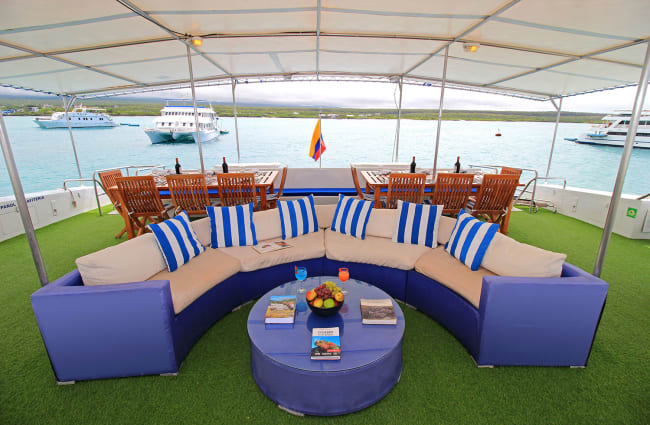
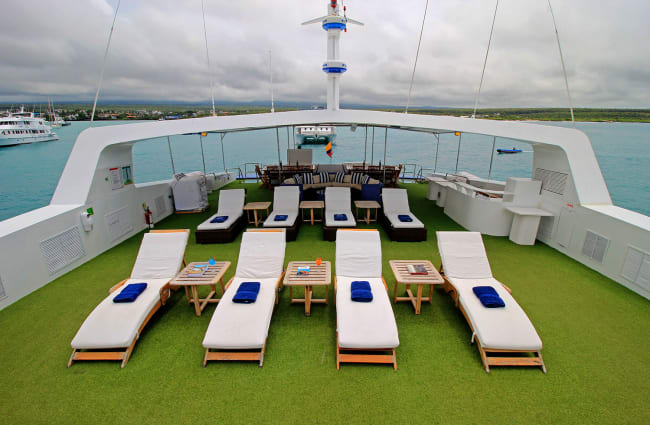
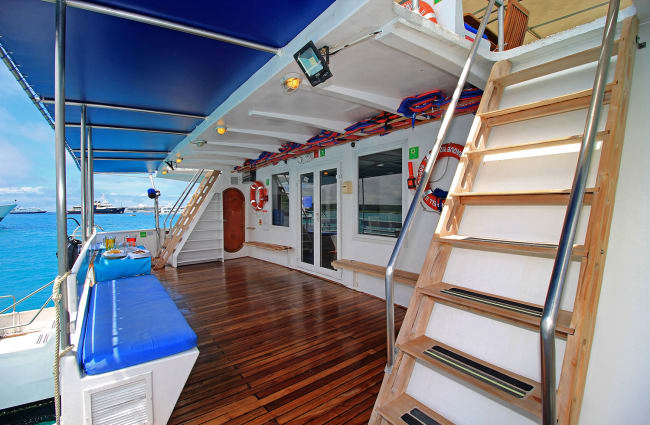
Suites & Cabins
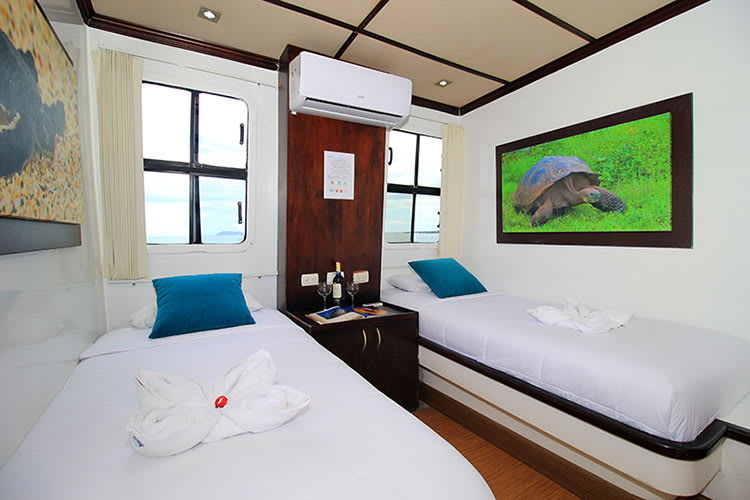
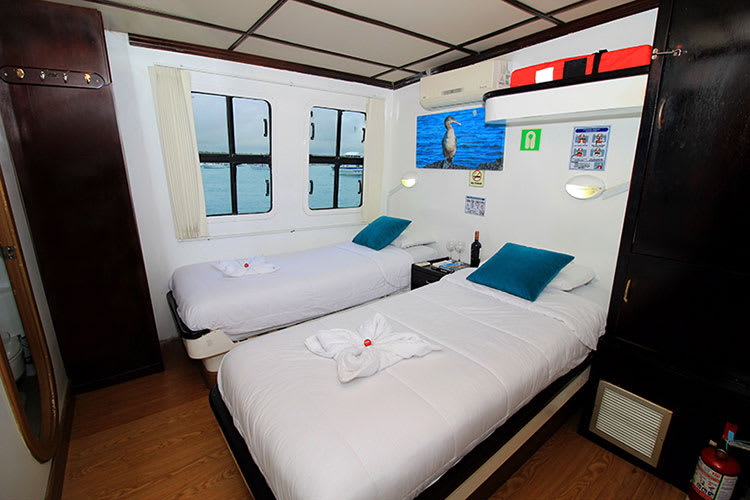
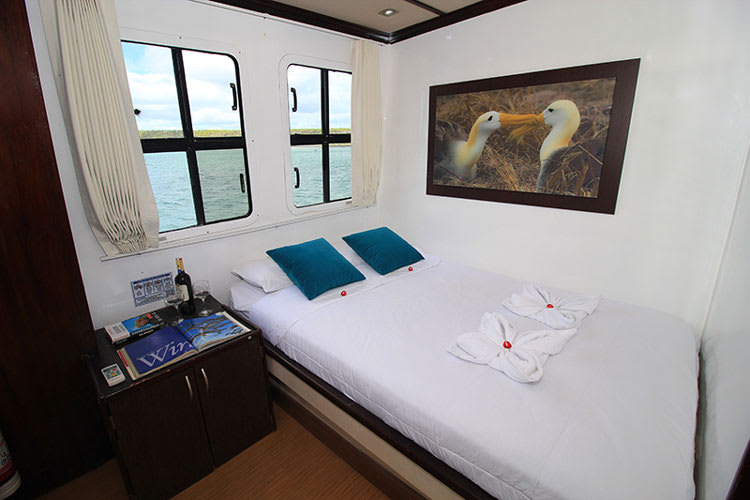
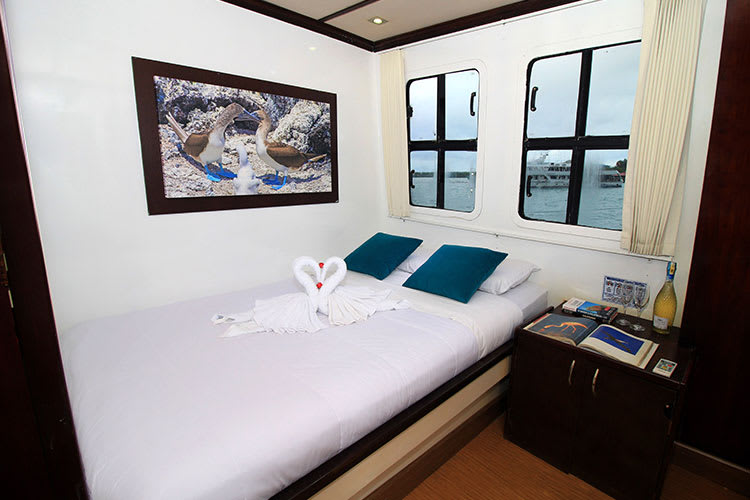
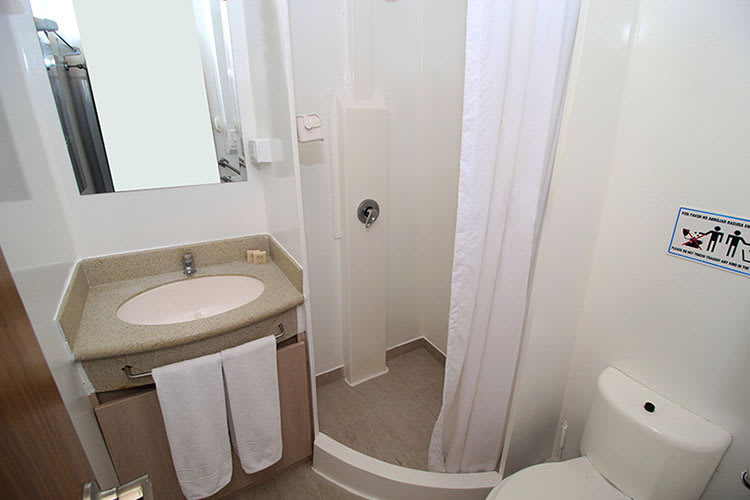
Standard Cabin
All staterooms are fully air-conditioned, have storage space, come equipped with 110V sockets, and boast their own private bathroom with shower and hairdryer.
Cabins 1 & 2 at the front of the catamaran have fixed double beds, 3-6 have fixed twin beds, and cabins 7 & 8 at the rear have twin beds that can be converted into a double bed.
Related Cruises
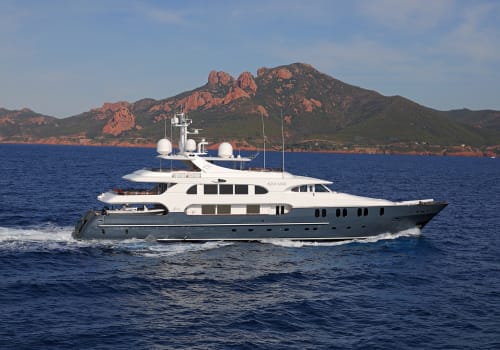
- Galapagos
- Ecuador
Aqua Mare

- Galapagos
- Ecuador
Cormorant II
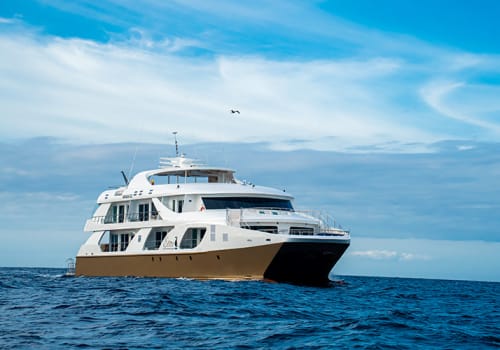
- Galapagos
- Ecuador
Elite

- Galapagos
- Ecuador
Galaxy Sirius
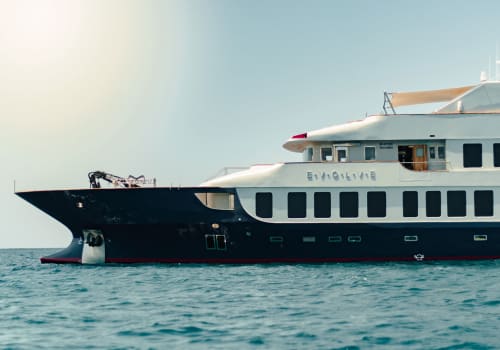
- Galapagos
- Ecuador
Origin, Theory & Evolve
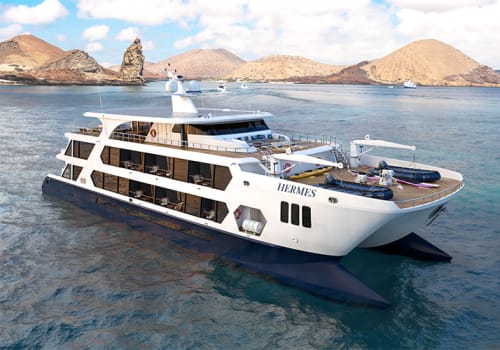
- Galapagos
- Ecuador
Hermes
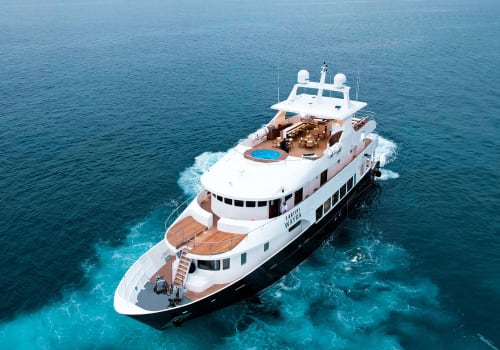
- Ecuador
- Costa Rica
Kontiki Wayra
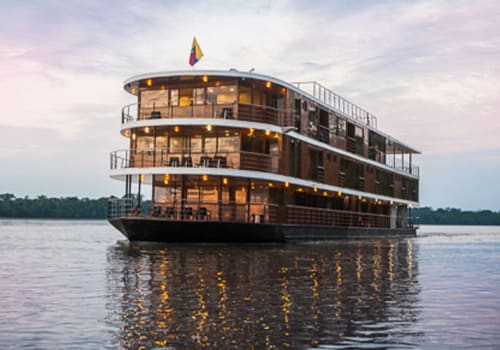
- Amazon
- Ecuador
Anakonda
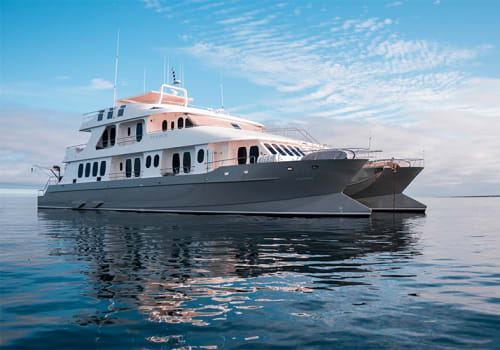
- Galapagos
- Ecuador
Alya
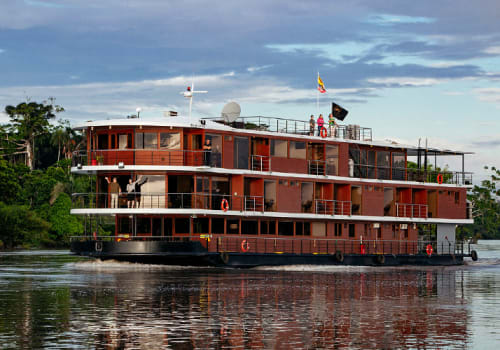
- Amazon
- Ecuador
Manatee Amazon Explorer

- Galapagos
- Ecuador
Endemic
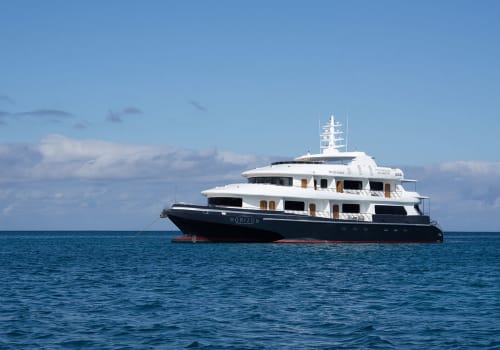
- Galapagos
- Ecuador
Galapagos Horizon
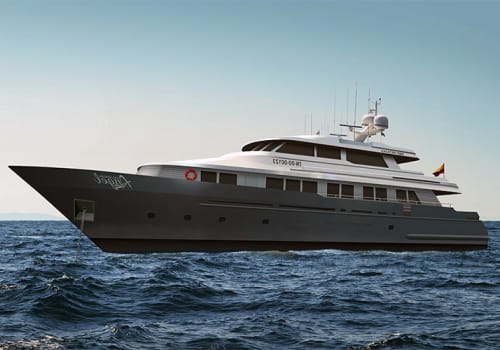
- Galapagos
- Ecuador











